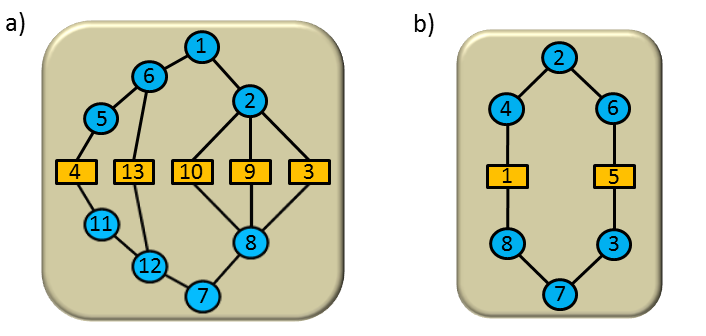Sockets detection
BlurredPixel company is a leading video card manufacturer. The layout of its latest cards consists of many nodes connected with wires
transferring the signal that is being processed. There are two types of nodes: processors and sockets.
The wire network is mirror-symmetric. In the middle of a card, there is a layer 𝒮 of sockets connected to
a network 𝒫1 of processors above and to a network 𝒫2 of processors bellow.
The processors of network 𝒫1 with their wire
connections form a tree having the sockets of layer 𝒮 as its only leaves. The processors of network 𝒫2
also form a tree which is the mirror image of the tree formed by network 𝒫2.
And again, all the sockets of layer 𝒮 are the only leaves of this second tree. Two examples of video cards are given in Image 1.
Recently, the company found notes on a breakthrough video card layout, made by their former chief engineer who mysteriously disappeared.
Unfortunately, the notes are not complete. There is a flash disk included which contains a data file with all connections of the layout, but
it is not clear which nodes are processors and which are sockets. The company wonders if the data file can be used to reconstruct
the layout.

Image 1. Examples of video card layouts. Processors are depicted as blue circles, sockets are depicted as orange rectangles. Wires connecting nodes are represented by black lines. |
The task
Given a list of nodes and their wire connections, your task is to detect sockets.
Input
The first input line contains two integers N and M separated by a space. N is the number of nodes, M is the number of connections. Next, there are M lines, each of them containing integers A and B, separated by a space. Each such pair represents a connection between nodes A and B. Nodes are numbered from 1 to N. The nodes numbering as well as the order of connections is arbitrary. It holds that N ≤ 320000 and M ≤ 400000.
Output
The output consists of one line containing up to 100 integers, separated by spaces. The integers are the node numbers of the first 100 sockets in ascending order. If there are only S < 100 sockets, then only numbers of these S sockets are listed (in ascending order). If there are multiple feasible solutions to an input instance, the lexicographically minimal sequence of socket numbers is expected as the output.
Example 1
Input13 16 1 6 5 6 5 4 13 6 7 12 11 12 11 4 13 12 7 8 2 1 8 10 9 2 2 10 2 3 3 8 9 8Output
3 4 9 10 13The input of Example 1 data are depicted in Image 1a).
Example 2
Input8 8 3 5 8 1 8 7 3 7 1 4 2 4 2 6 6 5Output
1 5The input data of Example 2 are depicted in Image 1b).
Remark: There are more feasible solutions for the given input. Except the nodes 1 and 5, the sockets can also be e.g. the nodes 3 and 4. Since sequence 1 5 is the lexicographically minimal feasible solution, it is printed as the output.
Example 3
Input13 14 9 7 11 4 12 9 12 1 8 11 3 10 5 13 3 5 6 10 8 9 13 1 2 6 2 4 10 7Output
4 7 13
Public data
The public data set is intended for easier debugging and approximate program correctness checking. The public data set is stored also in the upload system and each time a student submits a solution it is run on the public dataset and the program output to stdout and stderr is available to him/her.
Link to public data set